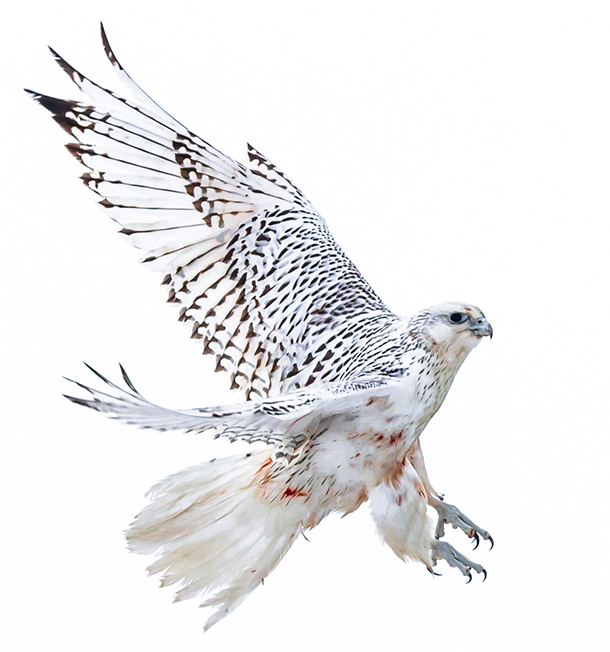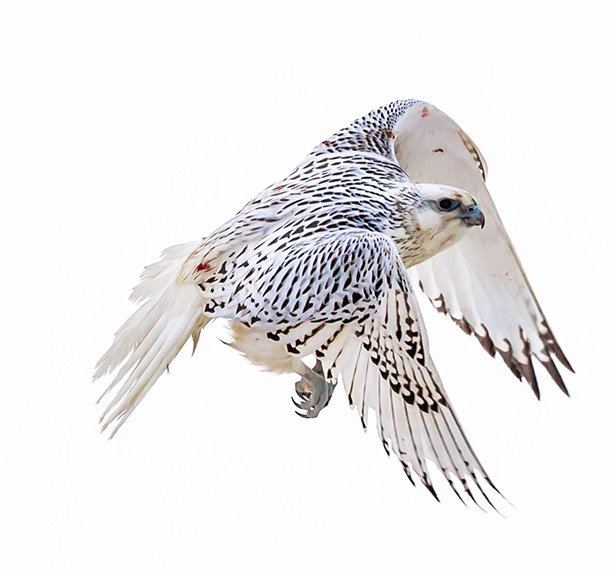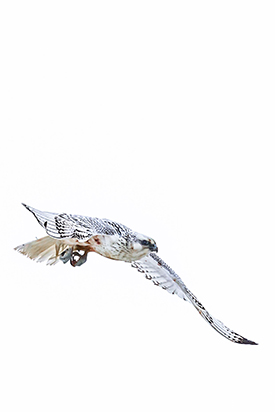Climate and the Majestic Gyrfalcon
Air Date: Week of January 25, 2019

The gyrfalcon is the largest falcon in the world. (Photo: Mark Seth Lender)
Climate disruption is bringing conflict between species that would under normal circumstances rarely encounter each other. Living on Earth’s Explorer in Residence, Mark Seth Lender, recounts a sobering encounter with a gyrfalcon injured by a rival peregrine.
Transcript
CURWOOD: Climate disruption is not only forcing people to move, it’s also changing the ranges of animals. This can lead to conflict as Our Explorer in Residence, Mark Seth Lender, found at Churchill Point in Northern Canada. There he saw two species of falcons that usually live in separate habitats meet on the frozen tundra.

Gryfalcon usually remain in the far north all year. (Photo: Mark Seth Lender)
LENDER: The Arctic wind comes blade flat, fleshing the thin and the fat from the bone of the land. Freezing, the breathe in your mouth the tears in your eyes your lips, turned to match the no-color perceived of every direction. Out of which blows Gyrfalcon! He closes his wings, and holds, the grains swirling, his feathers curling, hunkered, his head tucked into his shoulders with only himself for shelter.
And lifts. And like a ghost, gone. Into the fierceness…
Moments later he fights his way back, to the same roost. And the blizzard stops just the way it started, a shallow excuse for clearing: Thirty knots ten below. A weather Gyrfalcon does not bend to. As if it were nothing. Nothing at all. Knowing, there will be worse to contend with.
Gyrfalcon ruffles, and arranges, and tucks, in his plumage in the miserly light. He cocks his head and leans far to the side. And straightens. And looks the other way. And all the way round behind him.
Searching, for what? For something to kill? What for? There is blood on his feathers already. Fresh blood. He ate. He feasted. Now should spend his time cleaning himself. But does not do so except for his feet brought up with easy balance to his beak. Then only stands there.

When on the hunt, gyrfalcon often swoop low to the ground to sneak up on prey. (Photo: Mark Seth Lender)
Recognition dawns slowly. He is not blooded. The blood is, his own.
Puncture marks laid down in groups. In twos. In threes. And the deep wounds on his back. So many. They tell a story. That he was hit from behind, low, there above his tail and that the blow drove him down. And he rolled. And laid on his back. The defensive tears on the skin of his feet tell you that, and the blood on his breast and belly also. And on his face. Meaning, the falcon went for his eyes. A peregrine, that’s all, the only one it could be. Smaller, lighter by half but fast, and his talons honed, and his eye unswerving.
Peregrine cannot be blamed for who and what he is. But this was not the work of Nature.
We did this. We have dragged the Southard North and crushed the North against itself. The peregrine should not have been here. Not when Gyrfalcon came down.
This is our result. Gyrfalcon will survive the night. But not the winter.
CURWOOD: That’s Living on Earth’s Explorer in Residence, Mark Seth Lender. For photos, check out our website, LOE.org.
Links
For information on visiting Churchill Point contact Frontiers North Adventures
To learn more about the wildlife of Churchill Point visit Polar Bears International
Living on Earth wants to hear from you!
Living on Earth
62 Calef Highway, Suite 212
Lee, NH 03861
Telephone: 617-287-4121
E-mail: comments@loe.org
Newsletter [Click here]
Donate to Living on Earth!
Living on Earth is an independent media program and relies entirely on contributions from listeners and institutions supporting public service. Please donate now to preserve an independent environmental voice.
NewsletterLiving on Earth offers a weekly delivery of the show's rundown to your mailbox. Sign up for our newsletter today!
 Sailors For The Sea: Be the change you want to sea.
Sailors For The Sea: Be the change you want to sea.
 The Grantham Foundation for the Protection of the Environment: Committed to protecting and improving the health of the global environment.
The Grantham Foundation for the Protection of the Environment: Committed to protecting and improving the health of the global environment.
 Contribute to Living on Earth and receive, as our gift to you, an archival print of one of Mark Seth Lender's extraordinary wildlife photographs. Follow the link to see Mark's current collection of photographs.
Contribute to Living on Earth and receive, as our gift to you, an archival print of one of Mark Seth Lender's extraordinary wildlife photographs. Follow the link to see Mark's current collection of photographs.
 Buy a signed copy of Mark Seth Lender's book Smeagull the Seagull & support Living on Earth
Buy a signed copy of Mark Seth Lender's book Smeagull the Seagull & support Living on Earth

